|
|
|
Sort Order |
|
|
|
Items / Page
|
|
|
|
|
|
|
| Srl | Item |
| 1 |
ID:
192706


|
|
|
|
|
| Summary/Abstract |
Energy storage reduces total operational costs and greenhouse gas emissions on the grid, while enhancing resilience and renewables integration. This makes energy storage a cornerstone in decarbonization planning. However, project developers building new storage systems may be motivated by energy arbitrage and other revenue streams rather than reducing emissions. Using outputs from ReEDS, which optimizes total system cost, this paper investigates the impacts of marginal storage deployment based on competing environmental, financial and grid system operator interests until 2050. Due to economic motivations, storage developers in some Western states may wait and peak new storage installations around 2030, which maximizes profits and reduces emissions. Conversely, new storage projects in Eastern states are more financially attractive today, but will likely increase short-term GHG emissions unless more renewable electricity is added to the grid, requiring policy-based intervention to achieve further long-term GHG emission reductions. The Inflation Reduction Act may reconcile these competing incentives, but more policies are needed to increase storage deployment while maximizing the emission reduction effect of adding storage to the grid. Midwestern and Southeastern states where storage projects could increase emissions will benefit from tax credits under the IRA. Additional credits to accelerate renewables deployment would reduce long-term emissions from storage and realize decarbonization targets faster.
|
|
|
|
|
|
|
|
|
|
|
|
|
|
|
|
| 2 |
ID:
192705


|
|
|
|
|
| Summary/Abstract |
The environmental impact of the transport sector has a significant contribution in the carbon emissions. To reduce fossil fuel consumption and promote clean fuel, many countries are considering hydrogen as an alternative fuel and a bridge to sustainable development and achieve net zero target. Indian government has taken multiple policy initiatives to promote hydrogen fuel adoption in India. But nevertheless, the major presence of the multiple barriers limits the mass adoption of hydrogen as a preferred fuel. Therefore, identification and assessment of the key internal and external barriers of the hydrogen fuel vehicles adoption is required to mitigate the climate change issues. This study has identified and analyzed the barriers. The criticality assessment of the barriers is done by fuzzy based hybrid approach analytic hierarchy process. Later, sensitivity experiments are conducted to verify the robustness of the model. The findings of the study show that technical barriers are most critical barriers in the adoption of hydrogen fuel vehicles in India. The result of the study also indicates that India would require to build the hydrogen supply network and infrastructure, improve consumer awareness, favourable policies and develop efficient production technology for the mass adoption of hydrogen as a fuel.
|
|
|
|
|
|
|
|
|
|
|
|
|
|
|
|
| 3 |
ID:
192731


|
|
|
|
|
| Summary/Abstract |
Many countries have implemented policies to encourage higher Energy Efficiency (EE) implementation, but they seem insufficient and significant EE opportunities are unrealized. It is thus important to understand which internal strategic drivers can help further improve EE implementation by a firm. We develop a theoretical framework and empirically investigating how corporate strategy influences firms' EE implementation on top of EE policies. Drawing from the literature on Natural-resource-based view and Proactive Environmental Strategy, we hypothesize the impacts of several strategic capabilities, including shared vision, top management support and stakeholder integration on a firm's EE implementation. We test our hypotheses using combined secondary data of 572 publicly traded firms from the CDP report, COMPUSTAT Fundamentals North America and Global, and the World Economic Forum. Our study enriches the literature on firms' perceived EE drivers by dissecting the nuanced impacts of different strategic capabilities and exploring new dimensions. Our findings also suggest important policy insights in encouraging higher industrial EE implementation. It remains important to strengthen EE policies and regulation. However, to make further leaps in EE implementation, policy efforts could be spent in information campaigns helping redirect interpretation of EE improvements toward opportunities and away from risks/threats.
|
|
|
|
|
|
|
|
|
|
|
|
|
|
|
|
| 4 |
ID:
192750
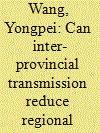

|
|
|
|
|
| Summary/Abstract |
Plagued by worsening pollution in load centers along the eastern coastal regions such as Beijing-Tianjin -Hebei, China is reducing local coal-fired power plants in those regions and relying more on inter-regional power transmission. In recent years, China has accelerated the construction of the West-East Electricity Transmission Project and planned and constructed a number of Ultra-high Voltage (UHV) transmission lines. However, how the impact of inter-regional transmission on carbon emissions needs empirical verification. This paper aims to study the carbon emission reduction effect of inter-regional transmission under nested models of the spatial econometric model for panel data. The empirical results show that although the non-dynamic spatial econometric analysis can find the carbon emission reduction effect of inter-provincial transmission, the long-term effect obtained by the dynamic spatial econometric analysis indicates that the inter-provincial transmission can bring about a slight increase in carbon emissions. The inter-provincial power transmission needs to be supported by sustainable share growth of renewable energy to achieve the targeted mitigation of carbon emissions.
|
|
|
|
|
|
|
|
|
|
|
|
|
|
|
|
| 5 |
ID:
192743


|
|
|
|
|
| Summary/Abstract |
In this paper, we analyze the carbon footprint of Castilla-La Mancha households, a region of the so-called “empty Spain,” and their mitigation potential. For this purpose, we use the environmentally extended multiregional input-output model and the Spanish Households Budget Survey to extract expenditure microdata by municipality size. We find that households in smaller municipalities have a larger total carbon footprint due to their higher direct emissions. Although their consumption is lower than other municipalities, they have a more intensive pattern of embedded carbon consumption. Households in smaller municipalities spend a higher share in private transport and housing-related activities, emitting almost an additional ton of direct carbon emissions.
|
|
|
|
|
|
|
|
|
|
|
|
|
|
|
|
| 6 |
ID:
192729


|
|
|
|
|
| Summary/Abstract |
Citizen engagement with Sustainable Energy Solutions (SES) is considered essential for the current energy transition, since decarbonization requires individuals to shift from passive consumers to citizens actively involved with the energy system. However, citizen engagement research has remained peripheral and scattered, particularly in what regards the drivers of engagement behaviors.
To address this challenge, this study examines how different forms of perceived value of SES (utilitarian, social, and environmental) influence different types of citizen engagement behaviors (information seeking, proactive managing, sharing feedback, helping other users, and advocating). To this end, we developed a quantitative study in the context of a H2020 EU project, with a sample of 456 citizens from the city of Alkmaar (the Netherlands).
Our findings show that the utilitarian value of SES has a significant effect on all the engagement behaviors, except for sharing feedback. Social value has a significant influence on the more socially related engagement behaviors, such as sharing feedback, helping other users, and advocating. Finally, environmental value has an indirect effect on information seeking, proactive managing, and advocating, but only when mediated through awareness of consequences. The implications of this study should allow SES providers to design more relevant offerings and policymakers to develop better citizen engagement strategies.
|
|
|
|
|
|
|
|
|
|
|
|
|
|
|
|
| 7 |
ID:
192740
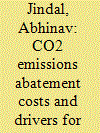

|
|
|
|
|
| Summary/Abstract |
Indian power industry contributes nearly half of its overall CO2 emissions. In this study, we answer three related questions. First, what is the abatement cost of CO2 emissions for the Indian thermal power industry under three different policy scenarios - business as usual, emissions reduction only, and simultaneous emissions reduction and energy efficiency enhancement. Second, what are the determinants of these abatement costs of CO2 emissions. Third, which abatement policy scenario is more beneficial. For this, we employ a plant level dataset covering 93% of installed capacity and use a parametric quadratic directional output distance function to estimate marginal abatement costs by applying deterministic linear programming methods. Our findings are: First, the abatement costs range between US$ 46.43–71.11 per ton CO2, depending on the policy scenario chosen. Second, plant age, location, size, ownership, and CO2 intensity are all significant drivers of abatement costs. Third, while greater emissions reductions are possible under the emissions reduction only scenario vis-à-vis simultaneous emissions reduction and energy efficiency enhancement scenario, both scenarios are compatible with meeting the Paris agreement goals. This paper helps decision makers to allocate CO2 abatement targets to plants in line with their abatement costs and potential.
|
|
|
|
|
|
|
|
|
|
|
|
|
|
|
|
| 8 |
ID:
192733
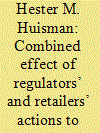

|
|
|
|
|
| Summary/Abstract |
Active consumer participation in retail markets is crucial for an affordable and sustainable energy transition. While energy regulators encourage active consumer participation through policies which decrease consumers’ switching costs, energy retailers seek to advance customer retention to boost profits. This study investigates how these seemingly opposing goals influence consumer participation in energy retail markets. Using data on the Dutch energy markets, we combine micro-economic and marketing insights through a retailer-aggregated panel vector auto-regression (VAR) model and a market-level VAR to analyse the dynamic interactions. The results indicate that the regulator affects consumer participation both directly and indirectly through energy retailers’ actions. We conclude that energy retailers’ acquisition and retention actions do not counteract the regulator’s efforts to increase active consumer participation. While retention actions lead to decreased switching behaviour, they concurrently decrease perceived switch costs while increasing search behaviour and the consideration to switch. Therefore, retention actions may still improve consumer welfare. Our research reveals mediating relations that require comprehensive examination of the overall impacts of regulatory policies and energy retailer’s actions.
|
|
|
|
|
|
|
|
|
|
|
|
|
|
|
|
| 9 |
ID:
192737


|
|
|
|
|
| Summary/Abstract |
Our study compares the convergence of CO2 emissions in countries at different stages of development based on two measures of CO2 emissions (production and consumption approach). It examines the effect of globalisation and environmental policy stringency on CO2 emissions convergence. We employ panel data from 38 countries from the period between 1992 and 2019 and apply the DCCE-MG model. The results reveal absolute convergence, which means that countries at different stages of development converge differently, as well as conditional convergence in both developed and developing economies, although it is faster in latter. The most important finding is that convergence alone is insufficient to positively assess climate policies implemented in particular countries, as in developing countries average CO2 levels increase relatively rapidly, whereas in developed countries they decrease slowly. The analysis of the determinants indicates that the CO2 convergence process in developing countries – unlike in developed countries – is significantly influenced by more stringent environmental policies and increasing globalisation, while renewable energy consumption and industrialisation do not exert any impact on this process. The impact of GDP levels is ambiguous. Moreover, the impact of globalisation depends on the measure of CO2 emissions, and this relationship is stronger in consumption emissions than in production ones.
|
|
|
|
|
|
|
|
|
|
|
|
|
|
|
|
| 10 |
ID:
192739


|
|
|
|
|
| Summary/Abstract |
Accurately recognizing the impact and mechanism of PM2.5 on firms is essential for China to achieve both the reduction of PM2.5 and economic growth. Based on the differing levels of PM2.5 concentration between both sides of the 800 mm isoline, we construct a quasi-natural experiment to investigate the impact of PM2.5 on firm evolution and regional economic efficiency. We further evaluate the role of government governance in achieving both PM2.5 reduction and regional economic efficiency improvements simultaneously. Results indicate that M2.5 disturb the process of firm evolution and influences regional economic efficiency through different effects. More importantly, the results show that in regions with strong governance, reducing PM2.5 could improve macroeconomic efficiency without hampering economic growth. In contrast, regions with weak governance tend to experience an increase in PM2.5 severity as economic growth advances. The evidence presented in this paper on the relationship between PM2.5 and economic development provides a new perspective to formulate policies for policymakers.
|
|
|
|
|
|
|
|
|
|
|
|
|
|
|
|
| 11 |
ID:
192753


|
|
|
|
|
| Summary/Abstract |
Germany has ambitious goals to steeply increase the thermal energy efficiency of its older residential buildings, to reduce CO2 emissions and bring heating costs down, especially for low-income households who are over-represented in such dwellings. However, existing scholarship suggests it is doubtful whether the costs of renovation are offset by energy cost savings, even when renovating to only the most basic energy-efficiency standard. Renovating to more ambitious standards further increases the gap between costs and savings. This study offers a first attempt to quantify the dimensions of the problem and what it means for financing this ambitious goal. It analyses publicly available data on case studies of three of Germany's typical 1940s-1970s-era multi-apartment building types and three typical 1900s–1970s house types, retrofitted to a range of energy-efficiency standards in 2020–2021. It updates these for 2023 construction costs, energy prices, carbon prices and interest rates, and shows how rebound and prebound effects exacerbate the situation. Using cost-benefit analyses based on net-present values, payback is not achieved within 75 years in any scenario. The study concludes that Germany's goal can only be achieved through large financial inputs, i.e., sunk costs which will not be fully returned through energy savings.
|
|
|
|
|
|
|
|
|
|
|
|
|
|
|
|
| 12 |
ID:
192709


|
|
|
|
|
| Summary/Abstract |
Auctions are a widely used policy instrument to support the deployment of renewable energies (RE). Yet, their complex design raises concerns about explicitly or implicitly discriminatory effects against particular technologies. Such discriminatory effects would distort fair competition, reduce economic efficiency, and potentially violate European Union law.
Several studies analysed discriminatory auction design from a theoretical and simulation perspective but actual empirical evidence is limited. Here, we demonstrate the existence of technology discrimination in European RE auctions empirically. We apply a fractional logit model to empirically measure the impact of various auction design elements on the success of two technologies, solar PV and onshore wind, based on 57 European multi-technology RE auctions from 2011–2021.
Our results confirm the existence of discriminatory effects of several auction design elements in RE auctions, such as installation size restriction, support duration, realisation period, ceiling price, and financial prequalification. The results are stable against various robustness checks such as varying the countries included, the time frame, and the composition of the regions controlled for.
Our findings advance the understanding of explicitly and implicitly discriminatory effects against particular technologies in multi-technology auctions and we propose steps to reduce technology discrimination in future multi-technology RE auctions.
|
|
|
|
|
|
|
|
|
|
|
|
|
|
|
|
| 13 |
ID:
192724


|
|
|
|
|
| Summary/Abstract |
Reliable electricity is a key factor in improving the living conditions of households and sustainable development of countries. Developing country governments and international organizations address the question of how to obtain a reliable supply of electricity and thus eliminate power outages at the top of their political agendas. In this framework, the aim of this paper is to estimate the willingness to pay of Indian urban consumers for having a continuous supply of electricity, avoiding unexpected power outages, using contingent valuation method. Two different econometric approaches are used. The households in the survey have been asked to state their willingness to pay for five different types of outages. Empirical data from 1043 Indian households has been analyzed using double hurdle approach. The econometric results indicate that, among the investigated households with an average individual annual income around $1630,00, their willingness to pay to avoid power outage strictly depend on the length of outages ranging, on average, from $0.37 (2 h) $3.00 (12 h), that is, households prefer to reduce the duration of outages. Further, income and environmental attitude of respondents positively influence higher WTP to avoid power outages. Our findings provide useful insights for policy makers to design and promote more reliable and customer centric energy generation and distribution models.
|
|
|
|
|
|
|
|
|
|
|
|
|
|
|
|
| 14 |
ID:
192758


|
|
|
|
|
| Summary/Abstract |
Starting from the EU vision for Energy Communities (EC), our purpose is to support them by proposing a Digital Twin (DT) that includes a bi-level optimization model to deliver coordination, economic, social, and environmental benefits to its members that can be quantified as Key Performance Indicators (KPI). The diversity of EC members from the size and interest perspectives leads us to consider a bi-level optimization model. It offers support to individual consumers/prosumers (first level) and coordination for EC (second level). This model is embedded into a DT that replicates the EC and the operation of individual entities such as consumers/prosumers and public assets. The DT is created as an automatic assistant with two components: iEMS – as a member's assistant and eEMS – as an EC assistant. These components optimize the schedule, generate bids for the Local Electricity Market (LEM) and control the flexible appliances of the participants to deal with deficits and surpluses. The DT receives input from EC members, LEM, metering system and improves the operation of the EC in a two-way continuous exchange data flow. Furthermore, it is a reliable framework to test and improve models, regulations and policies in emergent EC as DT provides alternatives regarding its functionalities: optimization, market operation, setting the clearing price, settlement, value sharing for distributing benefits, etc. It can be extended to support grid operators to design tariffs, testing regulation and offer additional energy services. The proposed DT model is tested within an EC case study, both on a seasonal and an annual basis. The average trading index on LEM is 0.6 during the summer and 0.3 during the winter months, while the Degree of Local Sufficiency (DLS) for the EC is 0.45 in summer and 0.28 in winter. Moreover, the proposed LFM model reduces the exchanges with the main grid by an average of 45 kW in summer, that represents almost 15% of the average exchange at peak hours.
|
|
|
|
|
|
|
|
|
|
|
|
|
|
|
|
| 15 |
ID:
192749
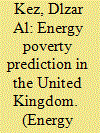

|
|
|
|
|
| Summary/Abstract |
Energy poverty affects billions worldwide, including people in developed and developing countries. Identifying those living in energy poverty and implementing successful solutions require timely and detailed survey data, which can be costly, time-consuming, and difficult to obtain, particularly in rural areas. Through machine learning, this study investigates the possibility of identifying vulnerable households by combining satellite remote sensing with socioeconomic survey data in the UK. In doing so, this research develops a machine learning-based approach to predicting energy poverty in the UK using the low income low energy efficiency (LILEE) indicator derived from a combination of remote sensing and socioeconomic data. Data on energy consumption, building characteristics, household income, and other relevant variables at the local authority level are fused with geospatial satellite imagery. The findings indicate that a machine learning algorithm incorporating geographical and environmental information can predict approximately 83% of districts with significant energy poverty. This study contributes to the expanding body of research on energy poverty prediction and can help shape policy and decision-making for energy efficiency and social fairness in the UK and worldwide.
|
|
|
|
|
|
|
|
|
|
|
|
|
|
|
|
| 16 |
ID:
192720


|
|
|
|
|
| Summary/Abstract |
Energy vulnerability has received sustained attention in global energy research related to energy security and poverty. However, energy quota trading (EQT), which aims to reduce energy consumption and intensity, has the potential to impact energy vulnerability substantially. This study scrutinizes the effect of EQT on energy vulnerability using a difference-in-difference model, relying on a quasi-natural experiment of China's EQT pilot. The findings show that EQT can significantly reduce energy vulnerability by 4.2%, which helps improve energy resilience. In addition, EQT can reduce the proportion of coal in energy consumption, thus reducing energy vulnerability. Finally, the ameliorating effect of EQT on energy vulnerability is particularly pronounced in areas with high resource dependence and low marketization. This research not only expands the understanding of the relationship between EQT and energy vulnerability, but also provides valuable assistance for future EQT policies from pilot to full-scale implementation.
|
|
|
|
|
|
|
|
|
|
|
|
|
|
|
|
| 17 |
ID:
192708
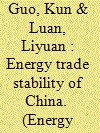

|
|
|
|
|
| Summary/Abstract |
As the world's largest importer of energy, China has been facing severe energy security issues. In the context of the challenges of global energy transformation brought about by climate change and the intensification of global political risks, a survival analysis approach is used in this paper to investigate China's energy trade stability. The results show that the energy trade linkages between China and 153 other countries are complex and unstable, featuring short periods of trade with many countries. Specifically, geopolitical riskier areas, such as the Middle East and Africa, have the lowest trade stability. The survival curves also demonstrate clear heterogeneity among different types of energy. Climate risks, including both physical and transitional risks, are found to have significant effects on energy trade stability. Finally, several policy options are proposed to improve energy trade stability in China, paying special attention to the increasing globe climate risks.
|
|
|
|
|
|
|
|
|
|
|
|
|
|
|
|
| 18 |
ID:
192713


|
|
|
|
|
| Summary/Abstract |
This paper examines the impact of EU energy policies, namely the National Energy and Climate Plans (NECP19) and REPowerEU (2022), on the European natural gas security of supply. Our analysis shows that the REPowerEU plan significantly cuts gas demand by 133 bcm compared to NECP19. This shift can make Europe independent from Russian gas by 2030. Executing REPowerEU requires faster, clean technology deployment. The EU needs to catch up in installations to reach REPowerEU targets, while NECP19 maintains high gas demand (423 bcm till 2030), potentially exacerbating gas import dependence. NECP19 not only raises gas demand but also brings substantial inter-annual variation (IAV) of demand. In cold years (twice in ten years), demand spikes by 39 bcm, and warm years (three in ten years) decrease it by 23 bcm. REPowerEU, while moderately increasing gas demand variation (around 7% versus NECP19), does not solve the demand variability issue. In extremely cold years (one in forty years), Europe may face a 46 bcm gap, around a quarter of the spot LNG market. Failing REPowerEU not only heightens gas import risk but also risks price spikes under varying climates and global market conditions. We offer policy recommendations to address potential price spikes related to IAV demand.
|
|
|
|
|
|
|
|
|
|
|
|
|
|
|
|
| 19 |
ID:
192711


|
|
|
|
|
| Summary/Abstract |
Demand-side flexibility which reacts to hourly price signals is expected to play an essential role in balancing intermittent electricity generation in the future carbon-neutral power system. This study investigates the price responsiveness of households and various influencing factors through a pricing experiment which was implemented as a reward scheme and involved 3746 Norwegian households. These households, characterised by a highly electrified energy usage such as electric heating and charging electric cars, were subjected to variable hourly price signals with a one-day advance notification over the course of three winter months. The study reveals that households reduced their electricity demand by, on average, 2.92% in hours with high prices, and the reduction did not diminish significantly after repeated interventions. Moreover, an increased response could be observed for price signals with a short peak price period and when prices exceeded a threshold of 15 NOK/kWh. These results suggest that despite the limited potential of manual demand response from households, it can still be relied upon and utilised to enhance power system operations and planning. Additionally, to fully exploit its potential, it is recommended to enhance price responsiveness through tailored price information and by incentivising investments in automatic response and energy storage.
|
|
|
|
|
|
|
|
|
|
|
|
|
|
|
|
| 20 |
ID:
192727
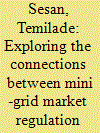

|
|
|
|
|
| Summary/Abstract |
About 140 million people across Africa are expected to gain access to electricity from mini grids by 2040. Nigeria, with the least dependable electricity supply on the continent, stands to benefit significantly from this boon. Accordingly, the government has put in place clear regulations to incentivise private investment and drive market growth. While the techno-economic dimensions of the growing mini-grid sector and the broader electricity industry have been extensively studied, less attention has been paid to analysing the impacts of the regulatory framework on the achievement of rural electrification and universal energy access goals. Drawing on qualitative data obtained from key regulatory and market actors in the Nigerian mini-grid sector, this paper interrogates the premise of pursuing widespread rural electrification through a regulatory framework that is primarily geared toward increasing market efficiency. The study finds that, while the current framework has enabled growth in the sector, complementary mechanisms are required to achieve equitable distribution of access, especially among the mainly rural populations dwelling on the fringes of mainstream electricity markets. The findings are instructive for practitioners and policy makers seeking evidence-informed approaches to achieving the goal of universal energy access in Africa.
|
|
|
|
|
|
|
|
|
|
|
|
|
|
|
|
|
|
|
|
|